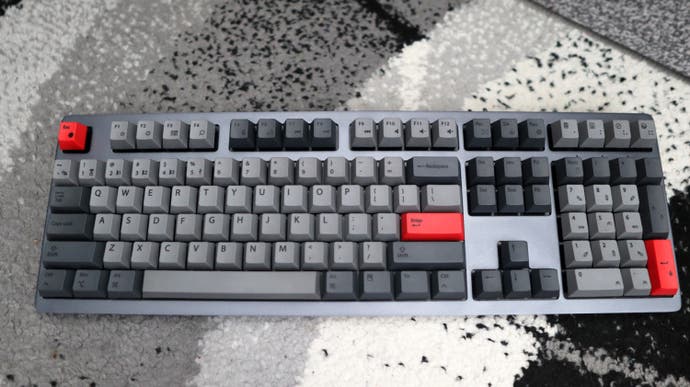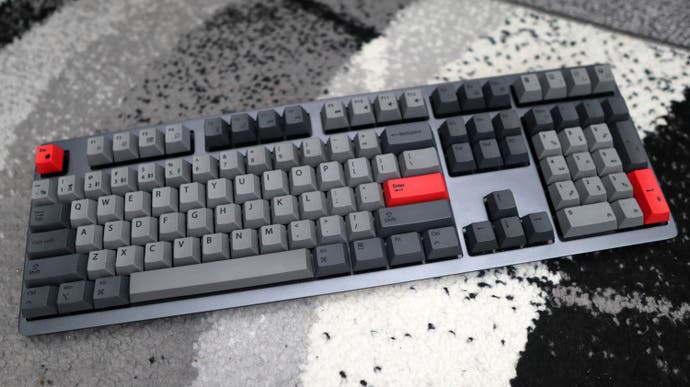Wombat Pine Professional review: an excellent keyboard for Windows and Mac
A do-it-all wireless mechanical keyboard for somewhat reasonable money.
Last year, I bemoaned the lack of Mac-friendly mechanical keyboards in my review of the Das Keyboard MacTigr. It seems that someone heard my calls, as I've got the Wombat Pine Professional sat on my desk to review. It may not be from a brand many of you know, but the parent company of Wombat, KSI (not that one) first made peripherals to pair with Apple's IIe four decades ago. Now they've released a full-size wireless mechanical keyboard that, on paper, looks like a solid option for Mac users looking to upgrade their typing experience without giving up the benefits of Mac-specific designs.
The Pine Pro, in its grey and black colourway here, looks classy and purposeful. The grey chassis keycaps and metal top plate match the Space Grey of my MacBook Pro nicely, as well as being a near-match to my Logitech MX Master 3S mouse I use for work, meaning everything ties together nicely. Considering Apple has always valued aesthetics, that's a big win for the Pine Pro. If this grey colourway isn't for you though, the Pine Pro is also available in other colourways including blue, green and pink for something a little more funky.
This is a sturdily built keeb too, especially with the combo of a half-plastic, half-anodised-aluminium case which offers no deck flex to speak of and a reassuring heft. The two level feet on the bottom of the keyboard also feel good; it's nice to have a choice of typing angle even if the default feels comfortable.

That excellent construction and attention to detail is also evident with a close inspection of the Pine Pro's PBT keycaps, which offer dye-sublimated legends that won't wearing off anytime soon, in stark contrast to cheaper keys with printed legends. The keycaps here don't appear to be double-shot though, but that's me being a little picky. What is handy is that they're printed with both Windows and Mac symbols - handy for those of us use Windows and MacOS regularly.
Of course, the real reason for buying the Pine Pro is what's underneath these keycaps. The Pine Pro comes with a choice of either Red or Brown switches, and while neither the box or website name their manufacturer, taking off the keycaps reveals these to be Cherry MX Browns as opposed to any clones. I'm someone who has used MX Browns on a daily basis in a variety of keyboards, and true to form, the ones in the Pine Pro feel excellent. They're ideal switches for long days of working and typing, with that reassuring soft tactile bump and a light force that make them snappy to use too. Unlike cheaper clones, these regenuine MXs feel consistent with every keypress which is important for typing.
The Pine Pro also comes with full NKRO (n-key rollover), a feature that both gamers and typists can get behind. In essence, this means you can push down as many keys as you like at once and they should all be recognised. Over the years, this has become more of a standard feature on gaming keyboards, but it can be a rarity in more general purpose designs. This is particularly useful for rhythm games and co-op titles played on the same keyboard, but it can come in handy for work too.

Connectivity comes in three flavours: Bluetooth, 2.4GHz wireless and wired USB-C cable. This offers you the chance to use the Pine Pro with up to three devices, and I found the connection here to be reliable and quick in switching between the bundled 2.4GHz USB dongle on my PC and Bluetooth on my Mac. Inside the keyboard is a 1000mAh LiPo battery that has lasted for two months for me so far and recharges over USB-C with the cable provided.
It's here where one of my only real gripes with the Pine Pro becomes apparent. As much as I'm a touch typist of sorts, and bouncing from key to key on the Pine Pro felt excellent, I will sometimes look down at the keys for things such as system functions, and if I'm working at dark, it's a little disconcerting that the Pine Pro doesn't come with any form of backlighting. It doesn't need to be the brash sea of RGB that I'm used to seeing on all manner of gaming keyboards, but just a simple white backlight would work a treat for working in lower-light environments.
There is some additional downloadable software from Wombat's website in the form of Wombat Pouch. The software only seems to work when the keyboard is plugged in, but it nonetheless provides functionality to create shortcuts and add software-specific hotkeys. You can also update the board's firmware with it.

So, how much does all of this cost then? The Pine Pro retails for $160 from Wombat's own online store, and that is a little bit dear for a full size mechanical keyboard, when you can get more affordable (and DF-recommended) options such as the Keychron K2 for less than half the price. It may not be full size, but it's hotswappable, wireless, with Mac and Windows layouts/keycaps and offers pretty good build quality for the price, too.
With this in mind, the Pine Pro is still an excellent keyboard for use with both Windows and macOS with some great switches, battery life and connectivity options. It also looks good and provides one of the sturdiest chassis I've had on a keyboard in a long time. Just note the lack of backlighting means it's only suitable for working and gaming in well-lit environments.









